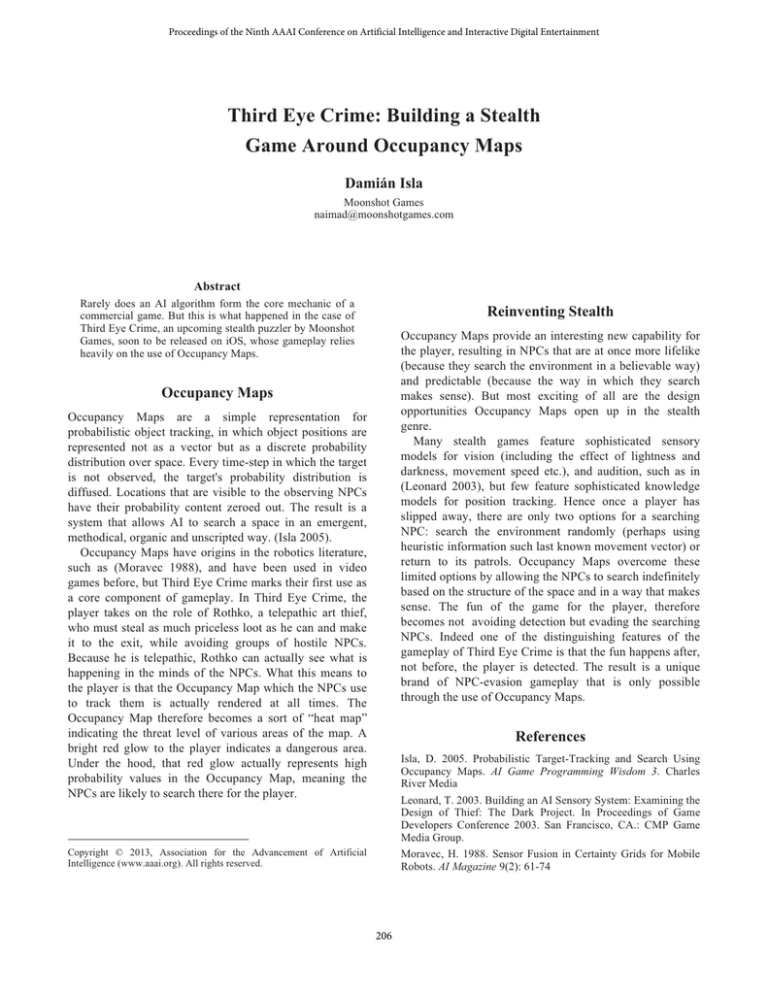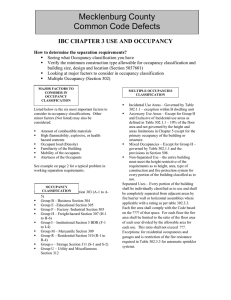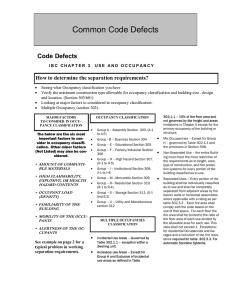
Proceedings of the Ninth AAAI Conference on Artificial Intelligence and Interactive Digital Entertainment
Third Eye Crime: Building a Stealth
Game Around Occupancy Maps
Damián Isla
Moonshot Games
naimad@moonshotgames.com
Abstract
Rarely does an AI algorithm form the core mechanic of a
commercial game. But this is what happened in the case of
Third Eye Crime, an upcoming stealth puzzler by Moonshot
Games, soon to be released on iOS, whose gameplay relies
heavily on the use of Occupancy Maps.
Reinventing Stealth
Occupancy Maps provide an interesting new capability for
the player, resulting in NPCs that are at once more lifelike
(because they search the environment in a believable way)
and predictable (because the way in which they search
makes sense). But most exciting of all are the design
opportunities Occupancy Maps open up in the stealth
genre.
Many stealth games feature sophisticated sensory
models for vision (including the effect of lightness and
darkness, movement speed etc.), and audition, such as in
(Leonard 2003), but few feature sophisticated knowledge
models for position tracking. Hence once a player has
slipped away, there are only two options for a searching
NPC: search the environment randomly (perhaps using
heuristic information such last known movement vector) or
return to its patrols. Occupancy Maps overcome these
limited options by allowing the NPCs to search indefinitely
based on the structure of the space and in a way that makes
sense. The fun of the game for the player, therefore
becomes not avoiding detection but evading the searching
NPCs. Indeed one of the distinguishing features of the
gameplay of Third Eye Crime is that the fun happens after,
not before, the player is detected. The result is a unique
brand of NPC-evasion gameplay that is only possible
through the use of Occupancy Maps.
Occupancy Maps
Occupancy Maps are a simple representation for
probabilistic object tracking, in which object positions are
represented not as a vector but as a discrete probability
distribution over space. Every time-step in which the target
is not observed, the target's probability distribution is
diffused. Locations that are visible to the observing NPCs
have their probability content zeroed out. The result is a
system that allows AI to search a space in an emergent,
methodical, organic and unscripted way. (Isla 2005).
Occupancy Maps have origins in the robotics literature,
such as (Moravec 1988), and have been used in video
games before, but Third Eye Crime marks their first use as
a core component of gameplay. In Third Eye Crime, the
player takes on the role of Rothko, a telepathic art thief,
who must steal as much priceless loot as he can and make
it to the exit, while avoiding groups of hostile NPCs.
Because he is telepathic, Rothko can actually see what is
happening in the minds of the NPCs. What this means to
the player is that the Occupancy Map which the NPCs use
to track them is actually rendered at all times. The
Occupancy Map therefore becomes a sort of “heat map”
indicating the threat level of various areas of the map. A
bright red glow to the player indicates a dangerous area.
Under the hood, that red glow actually represents high
probability values in the Occupancy Map, meaning the
NPCs are likely to search there for the player.
References
Isla, D. 2005. Probabilistic Target-Tracking and Search Using
Occupancy Maps. AI Game Programming Wisdom 3. Charles
River Media
Leonard, T. 2003. Building an AI Sensory System: Examining the
Design of Thief: The Dark Project. In Proceedings of Game
Developers Conference 2003. San Francisco, CA.: CMP Game
Media Group.
Moravec, H. 1988. Sensor Fusion in Certainty Grids for Mobile
Robots. AI Magazine 9(2): 61-74
Copyright © 2013, Association for the Advancement of Artificial
Intelligence (www.aaai.org). All rights reserved.
206





